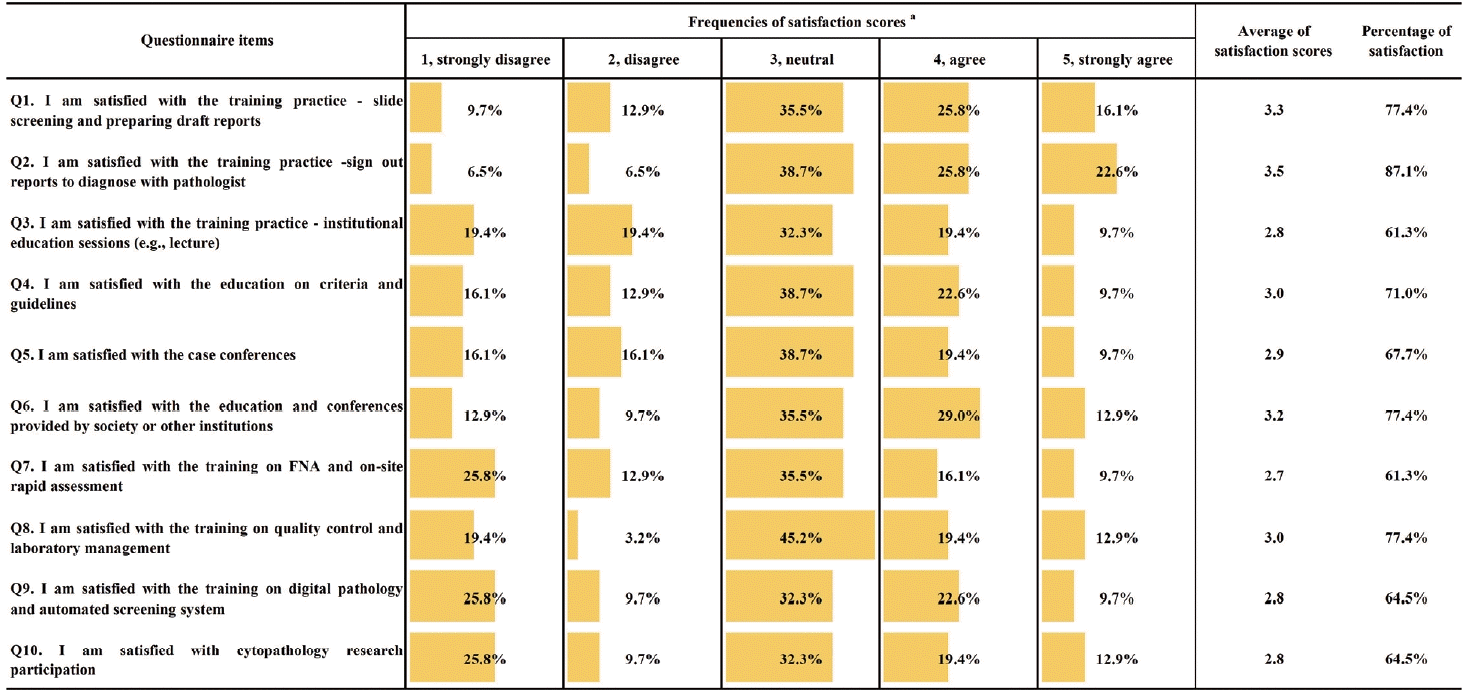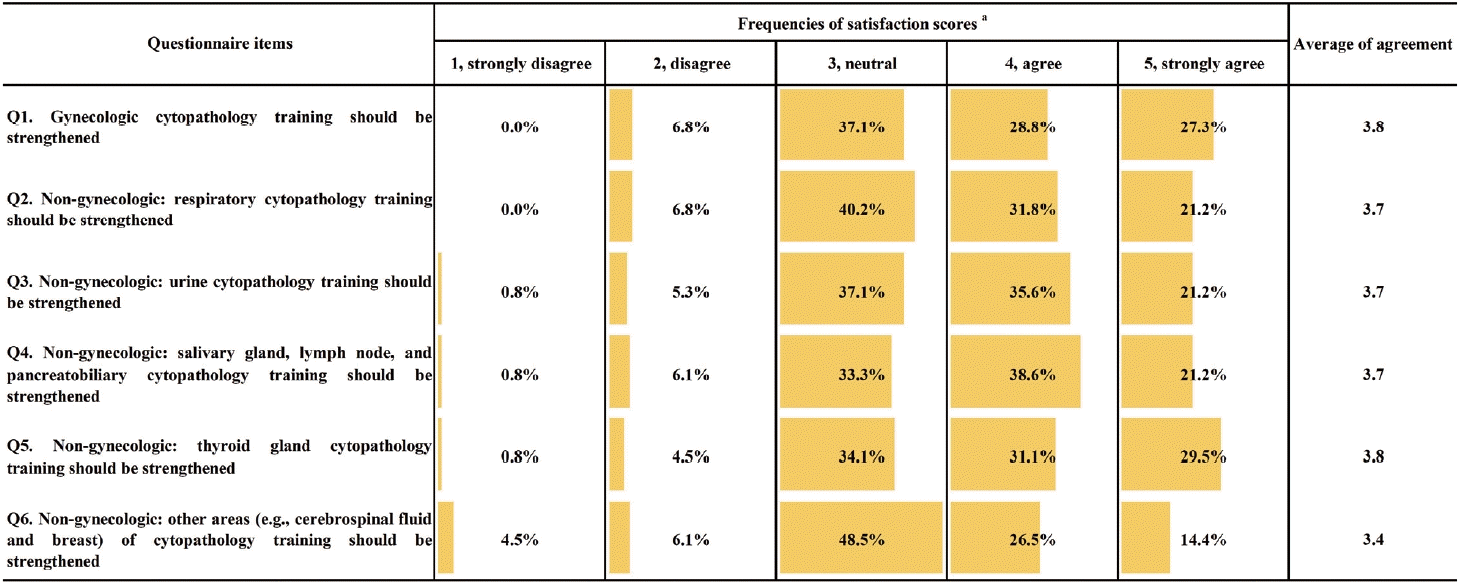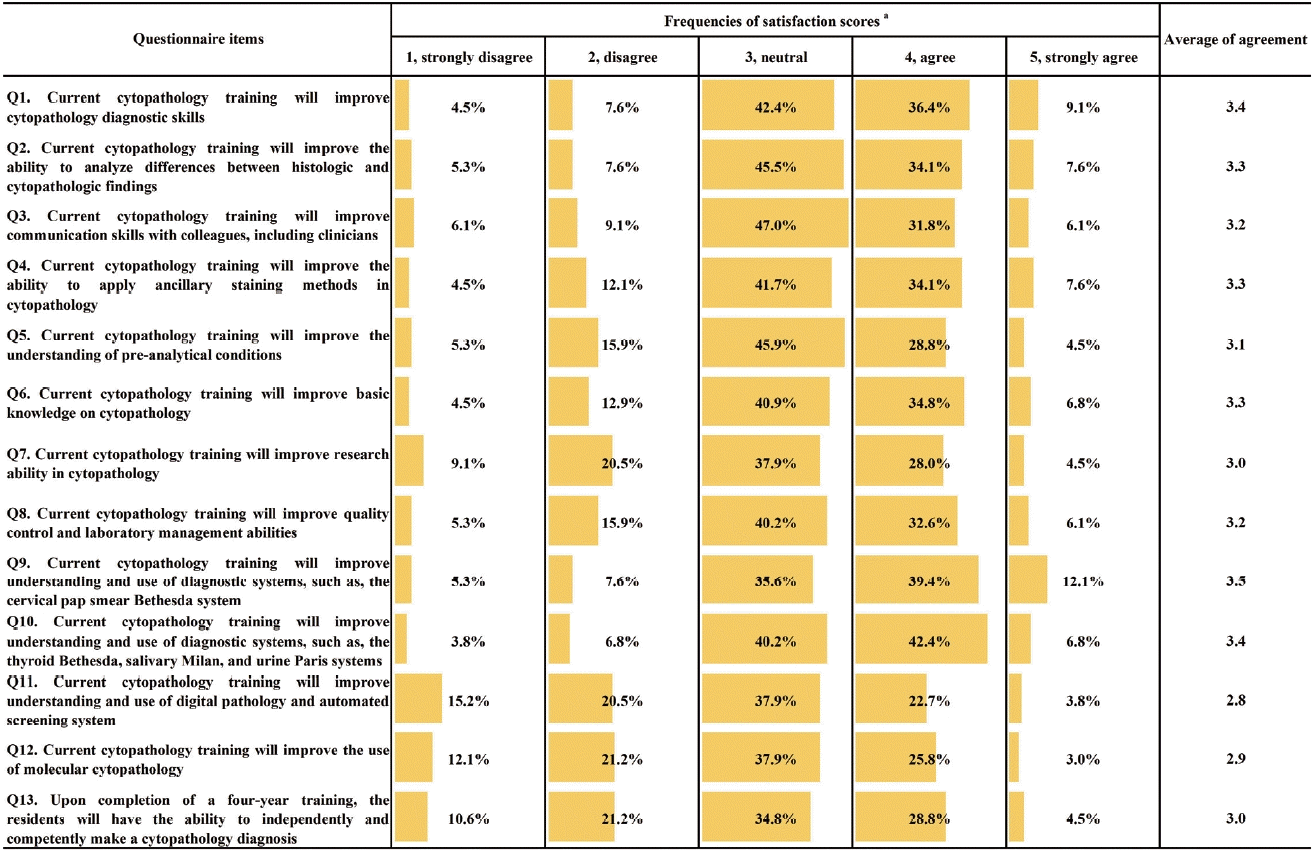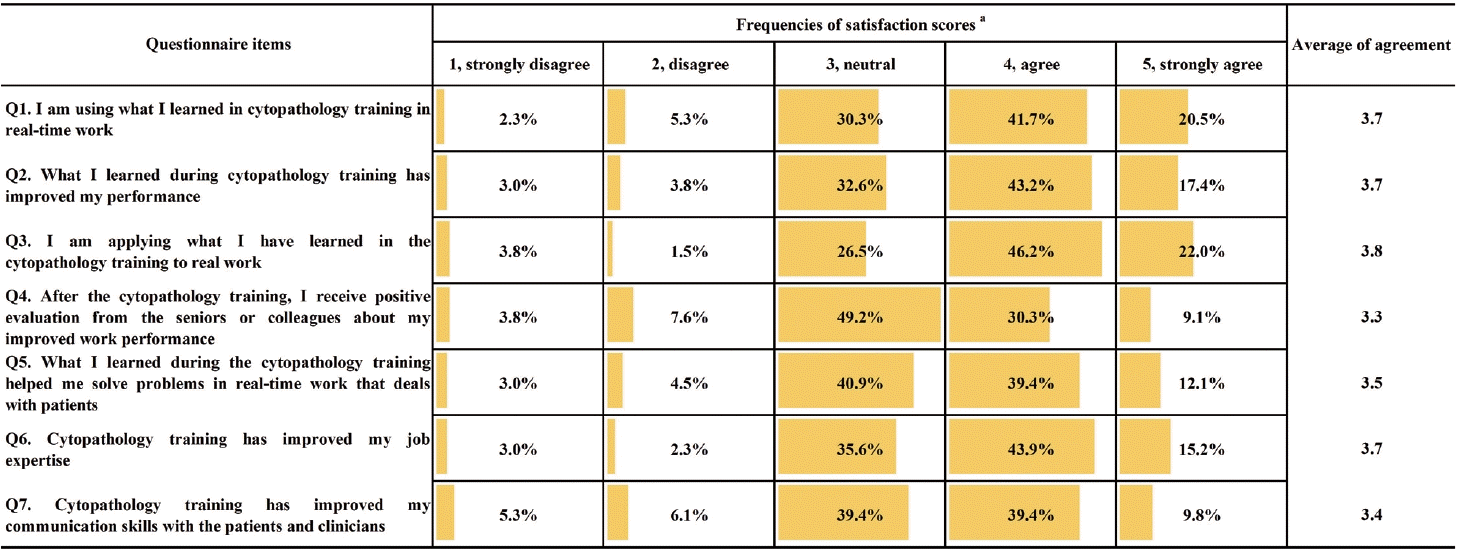This article has been
cited by other articles in ScienceCentral.
Abstract
Background
Although the Korean Society for Cytopathology has developed educational goals as guidelines for cytopathology education in Korea, there is still no systematic approach to cytopathology education status for pathology residents. Furthermore, satisfaction with cytopathology education and with the outcome of the current training/educational program has not been investigated in Korea. This study aimed to obtain comprehensive data on the current state of cytopathology education for residents and evaluate education outcomes.
Methods
An online survey was conducted in December 2020 for the board-certified pathologists and training residents registered as members of the Korean Society for Cytopathology. The questionnaire comprised questions that investigated the current status of cytopathology at each training institution, the degree of satisfaction with the work and education related to cytopathology, outcomes of cytopathology training, and educational accomplishments.
Results
Of the participants surveyed, 12.3% (132/1,075) completed the questionnaire, and 36.8% (32/87) of cytopathology residents participated. The mean overall satisfaction with cytopathology education was 3.1 points (on a 1- to 5-point scale, 5: very satisfied). The most frequent suggestion among the free description format responses was to expand educational opportunities, such as online education opportunities, outside of the individual institutions.
Conclusions
Our results showed that cytopathology training in Korea needs further improvement. We expect that this study will inform systematic training of competent medical personnel armed with broad cytopathology knowledge and strong problem-solving abilities.
Keywords: Cytopathology, Education, Residents, Statistics, Surveys
Cytopathology is important not only for disease diagnosis and healthcare but also for the Korean National Cancer Screening and Prevention Program [
1,
2]. The field of cytopathology has been a major component of pathology since its inception. The Korean Society for Cytopathology (KSC) was established nearly 40 years ago for quality control, development, and education in the field of cytopathology [
3].
Although the KSC develops educational goals as a guideline for cytopathology education in Korea, there has been no systematic approach to understanding the current cytopathology training status for pathology residents. In addition, satisfaction with cytopathology education and with the outcomes of the current training/educational program has not been investigated in Korea. There is also a concern that the current training program for pathology residents does not focus sufficiently on cytopathology, especially because the field is so clinically diverse and continues to play an important role in patient management and cancer screening.
As an initial step to ensure higher standards of cytopathology training, we conducted a survey among pathology residents and pathologists to obtain their views on the current status of cytopathology education and training. With the support of the KSC, this research aimed to obtain comprehensive data on the current state of cytopathology education for residents and to evaluate educational outcomes as a baseline evaluation for further improvement of cytopathology training in Korea.
MATERIAL AND METHODS
Survey participants and implementation
The survey was conducted among 988 board-certified pathologists and 87 training residents registered as members of the KSC. A series of questions addressing cytopathology residency training were developed, edited, and revised according to the KSC mission on clarity, quality, appropriateness, and importance. In December 2020, we conducted an online, confidential survey of KSC members. The questionnaire was uploaded onto an online survey site. KSC members were invited by email to participate, and an additional invitation was posted on social media for non-responsive residents.
Survey instrument and statistical analysis
The survey questionnaire included both closed- and open-ended questions. The questionnaire was divided into the following five sections: (1) general information, (2) current resident cytopathology training curriculum, (3) degree of resident satisfaction with the cytopathology training curriculum, (4) performance prediction and directions for improvement, and (5) training transfer. A total of 62 questions were included in the survey. Section 3 was filled out only by the pathology residents. These questions were rated on a 5-point Likert scale (5, strongly agree; 4, agree; 3, neutral; 2, disagree; and 1, strongly disagree). Residents who responded with 3, 4, or 5 were considered “satisfied”, and those who responded with 1 or 2 were considered “unsatisfied”. There were also open-ended questions about why responders were unsatisfied with the training curriculum and suggestions for improvements were requested (see Supplementary Data S1 for full survey and response statistics). Descriptive statistics were used to summarize demographics and outcome measures.
RESULTS
General information
The response rate for the survey was 12.3% (n=132/1,075). The respondents were 32 training residents (24.2%) and 100 board-certified pathologists (75.8%). The response rate among the residents was 36.8% (n=32/87). However, one of the resident responders did not participate in section 3; therefore, the total number of responses to this section was 31. Twenty-five of the board-certified pathologists were currently directors of the departments where they worked. By practice experience, 57% of the pathologists had more than 16 years, 9% had 11 to 15 years, 21% had 6 to 10 years, and 13% had less than 5 years. Furthermore, 29% of their institutions had residents in training at the time of the survey.
Current resident cytopathology training curriculum
This section was answered by residents and pathologists who had pathology residents in their institution. The proportion of respondents who answered that there was no training period exclusively dedicated to cytopathology was 52.5%. The proportion of those who had more than 3 months of cytopathology training was 36.1%. Regarding the percentage of training time allocated to cytopathology training or work time, 49.2% answered that cytopathology training comprised 10%–25% of the training period. The beginning of cytopathology education was most often in the second year of residency (59.0%), followed by the first (31.1%) and third years (9.8%). Most hospitals (63.9%) did not further divide the training program according to specific cytopathology fields (e.g., gynecologic vs. non-gynecologic). Of the respondents, 77.1% answered that the frequency of diagnosing cytopathology slides (i.e., signing-out) with the residents was more than 4 times per month. The following knowledge and skills were studied in Korean pathology departments: (1) screening of marked cytopathology slides, 85.2%; (2) preparing draft reports, 80.3%; (3) attending onsite rapid assessment of fine needle aspiration (FNA) or endobronchial ultrasound FNA, 44.3%; (4) screening of unmarked cytopathology slides, 41.0%; and (5) performing FNA, 1.6%. The majority of the institutions did not have designated conference time for cytopathology education (78.7%). In terms of the frequency of cytopathology education sessions, in 47.5% they occurred less than 3 times a year, and 31.1% reported none each year. Furthermore, regarding the frequency with which residents attended cytopathology conferences, seminars, or workshops held by the cytopathology society or other external organizations, 67.2% attended 2–6 times a year.
In the open-ended question, respondents were asked to express their opinion on the current cytopathology training program in Korea. Overall, 12% (16/132) of the respondents left comments, and the most common opinion was that the cytopathology society needed to organize more educational programs, especially further implementation of online education (from 10 respondents) (see Supplementary Data S1 for the other responses).
Degree of resident satisfaction with the cytopathology training curriculum
This section was answered only by residents who were in training at the time of the survey. This section asked questions that concerned three areas: (1) overall satisfaction with the cytopathology training program, (2) satisfaction with the training practices and specific training fields, and (3) satisfaction with the training environment. The mean overall satisfaction with the cytopathology training program was 3.1 (
Fig. 1). Satisfaction with training practice and specific training fields ranged from 2.7 to 3.5 (
Fig. 2). Sign-out with a senior pathologist was rated as the most satisfactory field of the training (average rating, 3.5). Training and onsite assessment of FNA specimens was rated as the most unsatisfactory field of the training (average rating, 2.7). Pathology residents rated satisfaction with the cytopathology training environment (e.g., number of teaching pathologists, reference bibliographies, and teaching or reference slides) as 3.2–3.3 (
Fig. 3).
Performance prediction and directions for the improvement
All the respondents answered questions in this section. We first asked whether practicing pathologists and residents were familiar with the current cytopathology training guidelines that were established by the KSC [
4]. According to the survey results, 41.7% of the participants acknowledged being aware of the guidelines, albeit not entirely familiar, while 46.2% reported not knowing the guideline. When the residents were asked whether the current education and training system could help them accomplish the training goals suggested by the KSC guidelines, 44.7% were neutral and 32.5% answered that they were likely to accomplish the training goal. Among the 42 responders who did not feel they would gain the ability to competently make a cytopathology diagnosis upon completion of training, lack of specific curriculum and training time (57.1%) and lack of diverse cytopathology cases during training (23.8%) were selected as the main reasons.
The second group of questions was about fields of training that needed strengthening. Among gynecologic and several non-gynecologic fields, gynecologic cytopathology and thyroid FNA were chosen as the training sectors that needed to be strengthened (average rating, 3.8) (
Fig. 4).
The third group of questions was about the predicted performance of the cytopathology training. The respondents expected that the current cytopathology training system would most likely enhance cytopathology diagnostic skills (average rating, 3.4) but was unlikely to enhance understanding and skills regarding digital pathology and automated screening systems (average rating, 2.8) (
Fig. 5).
In the open-ended question, respondents expressed the need for more exposure to diverse specimens, the need for an improved cytopathology training program, and continuing education for the pathologists who train residents. More opinions are provided in Supplementary Data S1.
Training transfer
Respondents mostly stated that they applied what they learned during cytopathology training in real-world practice (average rating, 3.7), that their cytopathology training enhanced their performance at work (average rating, 3.7), and that they have tried to apply what they learned in the training process to their actual work tasks (average rating, 3.8). Also, most residents stated that the cytopathology training program has enhanced their job expertise (average rating, 3.7) (
Fig. 6).
DISCUSSION
This study is the first survey addressing the current status and perspectives on cytopathology training in Korea. Globally, reports or surveys on the status of cytopathology training are scarce [
5-
8]. Based on the survey results, most institutions did not have an exclusive cytopathology training period for the residents (52.5% of respondents), and the training period was approximately 10%–20% of the workload. Mostly, the training comprised drafting a diagnosis in cytopathology cases (80.3%) that was prescreened and marked by cytotechnicians (85.2%). The residents had sign-out sessions with board-certified pathologists once (27.9%) or more than twice (49.2%) per week. There were very few intra-institutional cytopathology conferences or education sessions, less than three sessions per year.
The overall satisfaction rating on cytopathology education was 3.1 among the pathology residents. In specific fields, sign out sessions with board-certified pathologists were rated as the most satisfactory of the training program (average rating, 3.5), while training on the FNA technique was rated as the least satisfactory (average rating, 2.7). We found that the traditional training approach, which requires enhancing the experience through co-sign-out of the diagnosis and is often called apprenticeship education, was satisfactory and necessary. However, there seems to be little training time or education resources allocated to cytopathology training. The reality is that many board-certified pathologists have an excessive workload; thus, it may be difficult for them to dedicate additional time for residency training and co-sign-out. Our study underlines the importance of education through personal teaching and a co-sign out approach; therefore, a systematic effort to provide sufficient educational opportunities is needed.
The field of education that needs to be strengthened the most is gynecologic cytopathology and thyroid FNA cytopathology (average rating, 3.8). According to nationwide survey data, gynecology and thyroid FNA are the most frequently performed cytopathology examinations [
3]. The reason they were selected as an area that needed to be strengthened may be because of the high demand for those areas in real-time diagnostic work. Generally, most residents expected that they would be able to work independently and proficiently diagnose cases related to cytopathology after completing residency training (average rating, 3.0). However, many opinions have suggested that the lack of specific cytopathology training curricula and training time may affect residents’ competence in cytopathology. A lack of training time was noted in a European cytopathology training survey [
6]. The KSC developed training performance and goals for pathology residents, but few pathologists and residents were familiar with these guidelines (average rating, 2.5). It is necessary to reflect on the extent to which these guidelines have been used in individual institutions.
Even though there were many opinions that highlighted the lack of education and training time for cytopathology, the respondents rated training transfer questions as 3.0 or more. This suggests that cytopathology training has been useful and effective in the daily work of the respondents. Cytopathology training will progress if the results from this survey are reflected in future training development.
The low response rate is the major limitation of this survey. The response rate among residents (36.8%) was higher than that of board-certified pathologists (10.1%), but the responses may not fully reflect the opinions of all residents.
In this survey, there were several suggestions for improving cytopathology education in the future that seemed necessary. First, the respondents suggested that a systematic residency training program should be implemented at each institution. It is necessary to consider the strengths and weaknesses of the current training system and to reinforce areas with low satisfaction. Second, they suggested that guidelines for a systematic residency training program should be provided by the KSC. The goals and guidelines of current residency training state the depth of experience in diagnosis and fields that the residents should be trained in. However, there is no specific action plan, such as how the residents should be taught or the minimum training period required. This guide does not need to be regulatory or mandatory; however, it will still be helpful to each institution that attempts to improve their cytopathology training program [
7,
9]. Currently, the qualification requirement for pathology board certification does not include minimum educational participation hours in the field of cytopathology. Creating such a requirement could be one approach to increasing educational opportunities, such as intradepartmental cytopathology conferences or society education, and to encourage participation of residents in these educational opportunities. Lastly, the respondents suggested that more diverse educational programs should be provided by the academic society. Online education, case galleries, and clinical case-oriented education sessions were suggested as solutions. This survey was conducted at a time when most academic events were suspended due the coronavirus disease 2019 (COVID-19) pandemic. Therefore, the lack of educational opportunities reported may have been due to the COVID-19 situation. With these results, we hope that institutions and the KSC can develop more diverse educational programs, such as an on-demand online educational program. The KSC is currently developing an online educational site that reflects the study suggestions, and the site will be launched soon.
This study is expected to improve the quality of cytopathology education, provide opportunities to standardize cytopathology education for residents, and to serve as a basis for improvement in cytopathology education for both residents and practicing pathologists. We expect that this study will inform systematic training for competent medical personnel armed with broad knowledge of cytopathology and strong problem-solving abilities.
Supplementary Information
ACKNOWLEDGMENTS
The authors would like to acknowledge the Korean Society for Cytopathology for providing the funding necessary to conduct this study. We also thank the Fellowship Council and the Committee of Quality Improvement of the Korean Society for Cytopathology for its guidance in preparing and conducting this survey.
References
1. Lim SC, Yoo CW. Current status of and perspectives on cervical cancer screening in Korea. J Pathol Transl Med. 2019; 53:210–6.
2. Min KJ, Lee YJ, Suh M, et al. The Korean guideline for cervical cancer screening. J Gynecol Oncol. 2015; 26:232–9.
3. Oh EJ, Jung CK, Kim DH, et al. Current cytology practices in Korea: a nationwide survey by the Korean Society for Cytopathology. J Pathol Transl Med. 2017; 51:579–87.
5. Cohen MB, Perez-Reyes N, Stoloff AC. The status of residency training in cytopathology. Diagn Cytopathol. 1995; 12:186–7.
6. Herbert A, Cochand-Priollet B, et al. Survey of medical training in cytopathology carried out by the Journal Cytopathology. Cytopathology. 2010; 21:147–56.
7. Yu GH; Goals and guidelines for residency training in cytopathology. Goals and guidelines for residency training in cytopathology. Diagn Cytopathol. 2011; 39:455–60.
8. Gill B, Slater S. What should be done to improve cytopathology training in the UK? Cytopathology. 2010; 21:142–4.
9. Tambouret R, Nayar R, Pitman MB, Ehya H. Standardized cytopathology training through accreditation in the United States. Cytopathology. 2010; 21:139–41.
Fig. 1.
Overall satisfaction ratings provided by residents. a31 Responders answered.

Fig. 2.
Satisfaction with cytopathology training practices and specific training fields. FNA, fine needle aspiration. a31 Responders answered.

Fig. 3.
Satisfaction with the training environment. a31 Responders answered.

Fig. 4.
Areas of cytopathology training that should be strengthened. a132 Responders answered.

Fig. 5.
Performance prediction. a132 Responders answered.

Fig. 6.
Training transfer. a132 Responders answered.





 PDF
PDF Citation
Citation Print
Print









 XML Download
XML Download